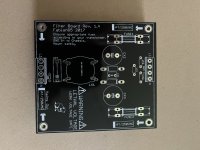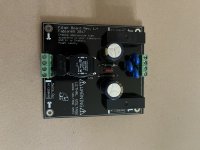I thought I would share my solution for easily prototyping passive crossover filters.
I designed and made a few modular boards that can easily be connected to each other. They make it easy to try out different topologies and to compare different component values. Here is an example of a basic 2nd order 3khz crossover with a 6db lpad on the tweeter.
Since my speakers (live edge open baffles) emphasize the beauty of natural wood, I decided to make these from solid walnut with a natural hemp oil finish. Completely unnecessary, I know, but hey, it makes me happy ;-) These boards weren’t the cheapeast or easiest to make, but I had fun making them.
Busbar
The busbar units feature two (2) push terminals and six (6) mini banana plug terminals, all wired to each other.
Typically I use one busbar module connected to the amp’s positive (+) terminal and one connected to the amp’s negative (-) terminal. If building a parallel crossover, I can branch out to each driver’s individual circuit.
Busbar JR
The busbar JR features one (1) push terminal and four (4) mini banana plug terminals, all wired to eachother.
These are useful in series crossovers and the occasional busy junction.
SP
The “SP” unit stands for “series parallel”. This module puts one component in series with the output and one component in parallel with the output. It can be used for many things, such as creating an LPAD, an RL high-pass filter or a 2nd order filter.
The inputs and outputs include two (2) positive input terminals (+), one positive output terminal (OUT +) and two (2) negative terminals. By doubling up the positive and negative terminals, these modules can easily be daisy-chained.
The series component is connected with two push terminals. This makes it very easy to swap components to try different component values. The series connection can be shorted with a short length of speaker wire to use the SP module as a single parallel component.
The parallel component is also connected with two push terminals. The parallel component can be omitted to use the SP module as single series component.
There is additionally a “bypass” DPDT switch that shorts the series component and opens the parallel path. With the bypass engaged, it is as if the components have been removed from the circuit.
SPSP
The “SPSP” unit stands for “series parallel series parallel”. This module acts like two SP units sequenced together, “A” and “B”. It can be used for many things, such as:
- A fourth-order high-pass or low-pass filter.
- A second-order high-pass AND a second-order low-pass filter.
- A second-order filter AND an LPAD.
- My personal favorite: an RL high-pass filter AND an LPAD.
The inputs and outputs include three (3) positive input terminals (+), two positive output terminal (OUT +) and two (2) negative terminals.
There are two DPDT switches. The first bypasses the first SP components (“A”), and the second bypasses the second SP components (“B”).
The switches open up lots of possibilities, such as:
- Compare different LPADs on “A” and “B”.
- Compare different second-order filters on “A” and “B”
Connections
I use small lengths of speakers wire with solder-on banana plugs to easily wire these modules together and to the speaker drivers.
Thanks for letting me share!


